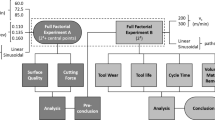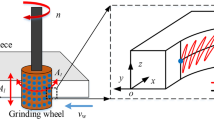Abstract
Maintaining the stability of material removal function has important implications for deterministic material removal processing. In this paper, the stability of material removal function for fixed abrasive tool polishing TC4 titanium alloy was studied by line scanning based on the polishing platform with the force-position hybrid control. The concept of curve similarity was introduced, and relative peak variation and average profile variation were proposed to quantify the change of material removal profile over time in fixed abrasive tool during the polishing process. Furthermore, material removal simulation model of line scanning was established. The influence rule of elastic layer material properties of fixed abrasive tool on profile of material removal and polishing stability was obtained. The experiment results indicated that the differences between the simulation material removal profile and the experiment results are small, as the hardness of the elastic layer of fixed abrasive tool increases, the width of the material removal profile decreases and the maximum removal depth increases. The relative peak variation and the average profile variation of fixed abrasive tool for elastic layer with Shore hardness of 50A are 0.125 ~ 0.176 and 0.253 ~ 0.326, respectively. The change range of material removal profile variation is small, and the similarity of the profile curve is high. The polishing stability evaluation index based on curve similarity can effectively quantify the time-varying nature of material removal profile of fixed abrasive tool, which provides a new evaluation index for the design and optimization of fixed abrasive tool for grinding and polishing.













Similar content being viewed by others
References
Li H, Huang H-Z, Li Y-F, Zhou J, Mi J (2018) Physics of failure-based reliability prediction of turbine blades using multi-source information fusion. Appl Soft Comput 72:624–635. https://doi.org/10.1016/j.asoc.2018.05.015
Li C, Wu B, Zhang Z, Zhang Y (2022) A novel process planning method of 3 + 2-axis additive manufacturing for aero-engine blade based on machine learning. J Intell Manuf 34:2027–2042. https://doi.org/10.1007/s10845-021-01898-6
Thepsonthi T, Özel T (2012) Multi-objective process optimization for micro-end milling of Ti-6Al-4V titanium alloy. Int J Adv Manuf Technol 63:903–914. https://doi.org/10.1007/s00170-012-3980-z
Wu D, Wang H, Zhang K, Lin X (2019) Research on formation mechanism and optimization method of surface waviness of TC4 blisk blade. J Manuf Process 39:305–326. https://doi.org/10.1016/j.jmapro.2019.02.031
Klocke F, Soo SL, Karpuschewski B, Webster JA, Novovic D, Elfizy A, Axinte DA, Tönissen S (2015) Abrasive machining of advanced aerospace alloys and composites. CIRP Ann 64:581–604. https://doi.org/10.1016/j.cirp.2015.05.004
Wang Z, Zou L, Luo G, Lv C, Huang Y (2022) A novel selected force controlling method for improving robotic grinding accuracy of complex curved blade. ISA Trans 129:642–658. https://doi.org/10.1016/j.isatra.2021.12.032
Liao L, Zhang Z, Meng F, Liu D, Liu J, Li Y, Cui X (2021) Novel rotary chemical mechanical polishing on an integral impeller. J Manuf Process 66:198–210. https://doi.org/10.1016/j.jmapro.2021.04.010
Chen Z, Shi Y, Lin X, Yu T, Zhao P, Kang C, He X, Li H (2019) Analysis and optimization of process parameter intervals for surface quality in polishing Ti-6Al-4V blisk blade. Results Phys 12:870–877. https://doi.org/10.1016/j.rinp.2018.12.056
Li Z, Zou L, Yin J, Huang Y (2020) Investigation of parametric control method and model in abrasive belt grinding of nickel-based superalloy blade. Int J Adv Manuf Technol 108:3301–3311. https://doi.org/10.1007/s00170-020-05607-0
Lv C, Zou L, Huang Y, Li H, Wang T, Mu Y (2022) A novel toolpath for robotic adaptive grinding of extremely thin blade edge based on dwell time model. IEEE/ASME Trans Mechatron 27:4429–4439. https://doi.org/10.1109/tmech.2022.3156804
Huai W, Lin X (2020) An optimization study of polishing efficiency of blisk and its technological parameters. Sci Prog 103:36850420957850. https://doi.org/10.1177/0036850420957850
Huai W, Shi Y, Tang H, Lin X (2017) Sensitivity of surface roughness to flexible polishing parameters of abrasive cloth wheel and their optimal intervals. J Mech Sci Technol 31:865–873. https://doi.org/10.1007/s12206-017-0140-2
Liu D, Shi Y, Lin X, Xian C, Gu Z (2020) Polishing surface integrity of TC17 aeroengine blades. J Mech Sci Technol 34:689–699. https://doi.org/10.1007/s12206-020-0114-7
Burge DWKS-WKJH (2009) Non-sequential optimization technique for a computer controlled optical surfacing process using multiple tool influence functions. Optics Express 17:21850–21866. https://doi.org/10.1364/OE.17.021850
Hu H, Qi E, Luo X, Zhang X, Xue D (2018) Rapid fabrication strategy for O1.5 m off-axis parabolic parts using computer-controlled optical surfacing. Appl Opt 57:F37–F43. https://doi.org/10.1364/AO.57.000F37
Yifan Dai CS, Peng X, Shi F (2010) Calibration and prediction of removal function in magnetorheological finishing. Appl Opt 49:298–306. https://doi.org/10.1364/AO.49.000298
Satake U, Enomoto T, Miyagawa T, Ohsumi T, Nakagawa H, Funabashi K (2019) Achieving stable removal rate in polishing with small tools. Precis Eng 55:248–253. https://doi.org/10.1016/j.precisioneng.2018.09.012
Burge DWKJH (2010) Rigid conformal polishing tool using non-linear visco-elastic effect. Opt Express 18:2242–2257. https://doi.org/10.1364/OE.18.002242
Suratwala T, Menapace J, Steele R, Wong L, Tham G, Ray N, Bauman B, Gregory M, Hordin T (2021) Mechanisms influencing and prediction of tool influence function spots during hemispherical sub-aperture tool polishing on fused silica. Appl Opt 60:201–214. https://doi.org/10.1364/AO.410903
Lin B, Jiang X-M, Cao Z-C, Huang T (2019) Development and theoretical analysis of novel center-inlet computer-controlled polishing process for high-efficiency polishing of optical surfaces. Robot Comput-Integr Manuf 59:1–12. https://doi.org/10.1016/j.rcim.2019.01.017
Jones RA (1995) Computer simulation of smoothing during computer-controlled optical polishing. Appl Opt 34:1162–1169. https://doi.org/10.1364/AO.34.001162
Jones RA (1980) Computer controlled polisher demonstration. Appl Opt 19:2072–2076. https://doi.org/10.1364/AO.19.002072
Xu C, Zhang Y, Liu J, Zhu Y (2021) Effect of offset on polishing surface shape convergence efficiency of the fixed abrasive tool head. Surf Technol 50:130–139. https://doi.org/10.16490/j.cnki.issn.1001-3660.2021.12.013
Wan Y, Pu M, Luo X, Li X, Fan B, Plummer WT, Guan F, Du H, Xie X, Song C, liang l (2019) Optimization of motion mode for improving the stability of removal function, 9th International Symposium on Advanced Optical Manufacturing and Testing Technologies: Advanced Optical Manufacturing Technologies. https://doi.org/10.1117/12.2505141
Funding
This work was supported by the Joint Funds of the National Natural Science Foundation of China (No. U20A20293).
Author information
Authors and Affiliations
Contributions
CX conducted various theoretical studies, designed the experiments, analyzed the results, and wrote the manuscript. WZ participated in the experimental work. YZ and YZ contributed to the review and edit for the literature. All authors read and approved the final manuscript.
Corresponding authors
Ethics declarations
Competing interests
The authors declare no competing interests.
Additional information
Publisher's Note
Springer Nature remains neutral with regard to jurisdictional claims in published maps and institutional affiliations.
Rights and permissions
Springer Nature or its licensor (e.g. a society or other partner) holds exclusive rights to this article under a publishing agreement with the author(s) or other rightsholder(s); author self-archiving of the accepted manuscript version of this article is solely governed by the terms of such publishing agreement and applicable law.
About this article
Cite this article
Xu, C., Zhang, W., Zhang, Y. et al. Material removal stability of fixed abrasive tool polishing based on line scanning. Int J Adv Manuf Technol 129, 2351–2360 (2023). https://doi.org/10.1007/s00170-023-12417-7
Received:
Accepted:
Published:
Issue Date:
DOI: https://doi.org/10.1007/s00170-023-12417-7




